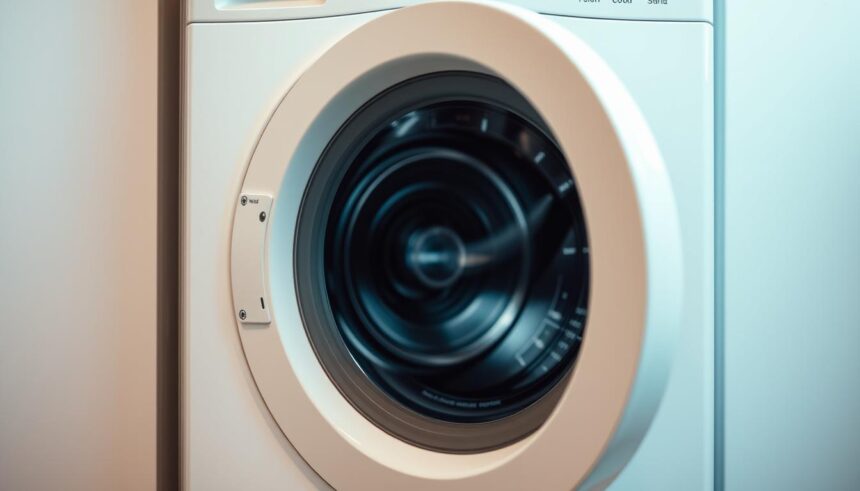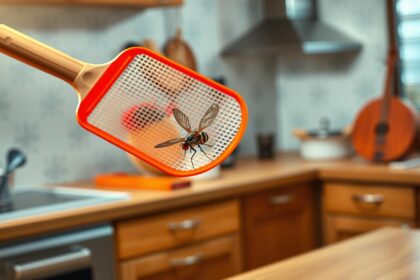Have you ever noticed your clothes smell less fresh after washing? This might mean your washing machine needs a clean. A dirty machine can cause poor washing and bad smells, harming your clothes and appliance.
Maintaining your washing machine is easier than you think. Regular care stops mold, mildew, and mineral buildup. This keeps your machine working well. We’ll show you how to keep your washing machine clean, whether it’s a front loader or top loader.
By following these simple tips, you’ll be able to enjoy fresher clothes and a longer-lasting washing machine. It’s time to give your washing machine the care it deserves.
Key Takeaways
- Regularly cleaning your washing machine improves its performance.
- Mold and mildew buildup can be prevented with proper maintenance.
- Simple steps can be taken to keep your washing machine fresh.
- Both front loader and top loader washing machines require regular cleaning.
- Proper maintenance can extend the lifespan of your washing machine.
Why Regular Washing Machine Maintenance Matters
Not many people think about how a dirty washing machine affects their daily life. A dirty washing machine can make your clothes dirty faster and use more energy. It can also damage your clothes and even harm your health.
The Hidden Costs of a Dirty Washing Machine
A dirty washing machine has hidden costs that can hurt your wallet and the environment.
Impact on Energy Efficiency
A dirty washing machine uses more energy. This is because dirt and debris make it work harder. This leads to higher bills for you.
Reduced Appliance Lifespan
Not taking care of your washing machine can make it last less time. This means you might have to spend a lot on repairs or get a new one too soon.
How Dirt Affects Your Clothes and Health
Dirt and bacteria in your washing machine can harm your clothes and health.
Bacterial Growth Concerns
Bacteria love dirty washing machines. They can cause bad smells and health problems.
Clothing Damage and Discoloration
Dirt and debris can ruin your clothes. They can make them look bad and last less time.
Signs Your Washing Machine Needs Cleaning
If your washing machine isn’t working as well as it used to, it’s time for a clean. It works hard to keep your clothes fresh. But, it can get dirty and affect its performance over time.
Unpleasant Odors and Their Causes
Unpleasant odors are a common sign your washing machine needs cleaning. These smells come from detergent residue, fabric softener, and debris. If it smells musty or sour, mold or mildew might be growing inside.
Visible Mold or Mildew
Visible mold or mildew means your washing machine needs cleaning. Look at the rubber gasket, detergent dispenser, and other moist areas. Black spots or white powdery residue mean it’s time to clean.
Poor Cleaning Performance
If your clothes aren’t as clean as they used to be, your washing machine might be dirty. Residue on freshly washed clothes is a sign of a dirty machine. This can make clothes stiff or look dingy.
Residue on Freshly Washed Clothes
Residue on clothes can come from too much detergent or a dirty machine. Use the right amount of detergent and clean your machine regularly to avoid this.
Unusual Noises During Operation
Unusual noises during the wash cycle are another sign. Dirt, debris, or an imbalance can cause strange sounds. Regular maintenance can help prevent these problems.
How to Clean Washing Machine: Essential Supplies
Before you start cleaning your washing machine, gather the right supplies. The correct materials will make the cleaning process easier and more effective.
Natural Cleaning Agents
You can use natural agents from your pantry to clean your washing machine. These eco-friendly options are gentle and effective.
Vinegar and Baking Soda Solutions
A mix of vinegar and baking soda is a great cleaning combo. Vinegar breaks down dirt, and baking soda is a gentle scrubber.
Lemon and Essential Oil Options
Lemon juice and essential oils (like tea tree oil) are good for cleaning and freshening up your machine.
Commercial Cleaning Products
If you want an easier way, there are commercial cleaning products available.
Washing Machine-Specific Cleaners
There are cleaners made just for washing machines. They’re designed to remove tough residue and odors.
Multi-Purpose Cleaners
Some multi-purpose cleaners work well too. Just make sure to check the manufacturer’s advice.
Tools and Equipment
You’ll also need some basic tools for cleaning.
Brushes and Cloths
A soft-bristled brush and microfiber cloths are good for scrubbing off grime gently.
Protective Gear
Remember to wear gloves to protect your hands from harsh chemicals and dirt.
Preparing Your Washing Machine for Cleaning
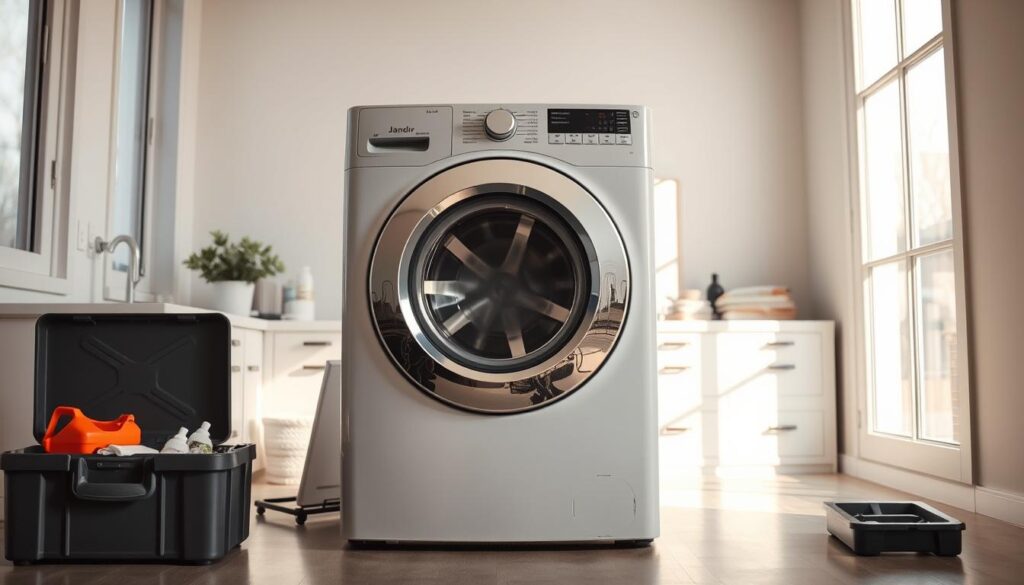
Getting your washing machine ready for cleaning is key. It makes sure the cleaning is safe and works well. You must take some steps before you start to avoid risks and damage.
Safety Precautions Before Starting
Before you start, it’s important to protect yourself and your washing machine. This is a safety first step.
Disconnecting Power
First, unplug your washing machine from the power outlet. This stops it from starting up by accident or getting an electrical shock.
Water Supply Considerations
Next, turn off the water supply to your washing machine. Find the shut-off valves behind it and turn them clockwise. This stops water from flowing into the machine while you clean.
Pre-Cleaning Steps
After you’re safe, you can start the pre-cleaning steps.
Removing Foreign Objects
Look in your washing machine drum for things like coins, keys, or loose items. These can damage your machine or mess up the cleaning. Take out any items you find.
Initial Wipe Down
Use a soft cloth or sponge to clean the outside of your washing machine. Wipe off any dirt or debris you see. This helps the cleaning go better.
| Pre-Cleaning Task | Purpose |
|---|---|
| Disconnecting Power | Prevents accidental start-ups and electrical shocks |
| Turning off Water Supply | Stops water flow into the machine during cleaning |
| Removing Foreign Objects | Prevents damage and ensures a smooth cleaning process |
Cleaning a Front Loader Washing Machine
Keeping your front loader washing machine in good shape is key. Regular cleaning is not just a good idea; it’s necessary. Front loaders use less water, which can cause moisture and mold buildup. By following simple steps, you can keep your machine working well.
Tackling the Rubber Gasket
The rubber gasket around the door is prone to mold and mildew. This is because it stays damp after each use. Cleaning it often is very important.
Removing Hidden Debris
To clean the gasket, pull it back and look for debris or mold. Use a soft-bristled brush or cloth to remove dirt or mold. Be careful, as this area can hide a lot of debris.
Disinfecting Techniques
After removing debris, mix equal parts water and white vinegar in a spray bottle. Spray the solution on the gasket, covering all surfaces. Let it sit for 10 minutes before wiping it down with a clean, damp cloth. This method helps disinfect and remove mold or mildew.
Cleaning the Detergent Dispenser
The detergent dispenser also needs regular cleaning. Soap residue and debris can build up, affecting its performance.
Disassembly Methods
Check your user manual to see if your dispenser can be taken apart. Many can be for a deeper clean. Remove big debris and soak the parts in warm, soapy water.
Removing Soap Buildup
For hard soap buildup, make a paste with baking soda and water. Apply it to the affected areas and let it sit for 30 minutes. Then, scrub gently with a soft brush and rinse.
Running a Cleaning Cycle
Running a cleaning cycle is a great way to deep clean your front loader. It removes detergent residue, fabric softener residue, and debris from the machine.
Temperature Settings
Use hot water for the cleaning cycle. High temperatures kill mold and mildew and dissolve detergent residue better.
Recommended Cleaning Agents
You can use a commercial washing machine cleaner or white vinegar. For a natural cycle, add 2 cups of white vinegar to the dispenser and run a hot water cycle without clothes.
| Cleaning Task | Frequency | Recommended Agent |
|---|---|---|
| Rubber Gasket Cleaning | Monthly | White Vinegar |
| Detergent Dispenser Cleaning | Every 2 Months | Baking Soda & Water |
| Cleaning Cycle | Every 3 Months | White Vinegar or Commercial Cleaner |
By following these steps and keeping up with regular cleaning, you can keep your front loader washing machine in great shape. This ensures it continues to clean your clothes well.
Cleaning a Top Loader Washing Machine
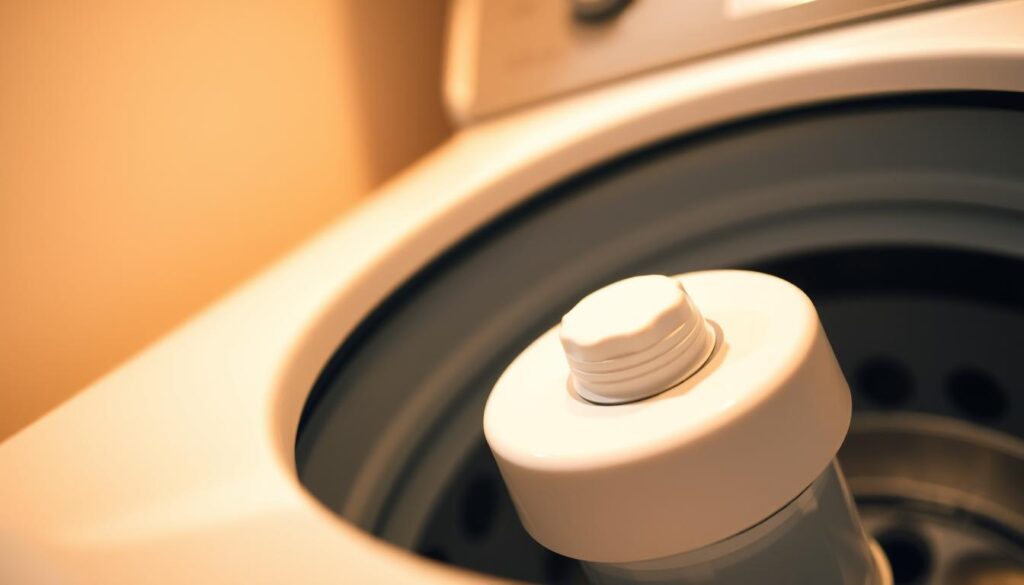
Keeping your top loader washing machine clean can make it last longer. Regular cleaning keeps it working well and your clothes smelling fresh.
Addressing the Agitator and Drum
The agitator and drum are key parts that need cleaning. Dirt, detergent, and fabric scraps can slow them down over time.
Removing and Cleaning the Agitator
To clean the agitator, start by taking it out. Your manual will tell you how. Soak it in warm soapy water to get rid of grime. Use a soft brush to scrub off tough stains.
To clean the drum, run a hot water cycle with vinegar or a cleaner. This removes detergent and odors. Adding a sanitizer can make it even fresher.
Cleaning the Lid and Exterior
The lid and outside of your washer also need cleaning. Dirt and spills can make them look dull.
Safe Cleaning Products for Different Finishes
For stainless steel, use a gentle cleaner and a soft cloth. For other finishes, a mild soap is safe. Stay away from harsh cleaners that can harm the surface.
Addressing Control Panel Areas
The control panel can get dirty, around the buttons and dials. Clean it with a damp cloth and dry it well to avoid damage.
Running a Maintenance Wash
Doing a maintenance wash is key to keeping your washer in good shape. It cleans the inside and removes buildup.
Cycle Selection
Use the hottest cycle for the maintenance wash. This ensures all dirt and residue are gone.
Optimal Cleaning Agents
For the maintenance wash, use a washer cleaner or white vinegar. Both are great for cleaning and freshening your machine.
By following these steps, you can keep your top loader washing machine in top condition. It will serve you well for many years.
Deep Cleaning the Filter and Drain Pump
To keep your washing machine running well, it’s important to clean its filter and drain pump often. These parts are key to the machine’s performance. If you ignore them, your machine might not work right and could even break down.
Locating Your Machine’s Filter
The filter in your washing machine catches debris to keep it from getting into the drain pump. Finding it is the first step to cleaning. The filter’s spot can change based on the brand and model of your machine.
Common Filter Locations by Brand
- Many brands have the filter at the bottom front of the machine.
- Some models have it behind a small door or panel.
Accessing Hidden Filters
Sometimes, the filter is hidden behind a panel or under the drum. Check your user manual for how to get to it.
Step-by-Step Filter Cleaning
Once you find and get to the filter, it’s time to clean it. Start by taking out any visible debris.
Removing Trapped Debris
Take out the filter and rinse it under running water to get rid of trapped debris.
Sanitizing Filter Components
For a deeper clean, soak the filter in warm soapy water. This will sanitize it and get rid of tough dirt.
Drain Pump Maintenance
The drain pump is also very important and needs regular care. Clearing blockages and checking if it works are essential steps.
Clearing Blockages
Look at the drain pump for any debris or blockages. Take out any foreign objects that might be stopping it from working.
Testing Proper Function
After cleaning, run a cycle to see if the drain pump is working right. Listen for any odd noises or vibrations.
By following these steps, you can deep clean your washing machine’s filter and drain pump. This ensures your machine keeps running well. Regular care is important to make your appliance last longer and keep your clothes clean.
Removing Stubborn Mold and Mildew
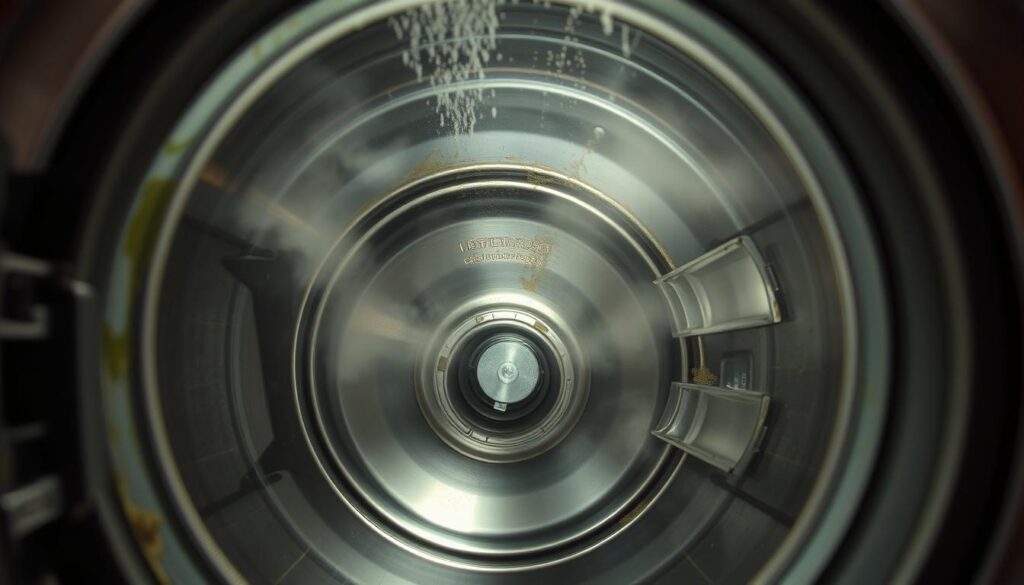
It’s important to get rid of mold and mildew in your washing machine. They can make bad smells and harm your health.
Safe Mold Removal Techniques
You can use chemicals or natural stuff to get rid of mold and mildew. Chemical solutions work well but might be too harsh.
Chemical Solutions
Chemical cleaners can kill mold and mildew fast. Look for ones with bleach or oxygen-based stuff.
Natural Alternatives
For a softer way, try white vinegar or baking soda. They’re gentle and don’t have harsh chemicals.
| Removal Method | Effectiveness | Environmental Impact |
|---|---|---|
| Chemical Solutions | High | High |
| Natural Alternatives | Moderate | Low |
Preventing Future Mold Growth
To stop mold and mildew from coming back, control humidity and do regular maintenance.
Humidity Control
Make sure your washing machine has good air flow. Open the door after you use it to help it dry.
Regular Maintenance Practices
- Run a cleaning cycle every month.
- Check and clean the gasket and detergent dispenser often.
By doing these things, you can keep your washing machine mold and mildew free. This keeps it working well.
Descaling and Removing Mineral Buildup
If you live in an area with hard water, you’ll face mineral buildup in your washing machine. This buildup can hurt your machine’s performance. It can make washing less efficient and might even damage it over time.
Identifying Hard Water Deposits
Hard water deposits show up in a few ways. Visual indicators include a white or off-white crust around the washing machine’s lid, detergent dispenser, or on clothes after washing.
Visual Indicators
- White or off-white crust around the lid or detergent dispenser
- Spots or stains on clothes after washing
Performance Issues
- Reduced washing efficiency
- Increased energy consumption
- Clothes feeling stiff or rough
Effective Descaling Methods
There are many ways to descale your washing machine. You can use commercial descalers or try DIY solutions. Commercial descalers are made to remove mineral deposits. You can find them at most hardware stores or home goods retailers.
Commercial Descalers
- Easy to use and made for washing machines
- Good at removing mineral buildup
DIY Descaling Solutions
- White vinegar: run a hot water cycle with 1-2 cups of vinegar
- Baking soda: run a cycle with 1 cup of baking soda
| Descaling Method | Effectiveness | Ease of Use |
|---|---|---|
| Commercial Descaler | High | Easy |
| White Vinegar | Medium | Easy |
| Baking Soda | Low-Medium | Easy |
Regional Water Hardness Considerations
Knowing your local water hardness is key to keeping your washing machine in good shape. You can test your water hardness with a simple kit from hardware stores.
Testing Your Water
A water hardness test kit can show you the mineral levels in your water. This helps you decide how often to descale.
Preventative Measures
- Regular descaling based on water hardness
- Using a water softener if you have very hard water
Best Washing Machine Cleaning Tips for Regular Maintenance
To keep your washing machine in top shape, regular care is key. Simple habits in your daily and weekly routine can help. This ensures your appliance works well.
Daily and Weekly Habits
Good habits can greatly improve your washing machine’s performance. For example, always leave the door open after use. This helps it dry and prevents mold and mildew.
Door and Gasket Care
Check and clean the rubber gasket around the door often. Use a mix of water and white vinegar on a soft cloth to clean it.
Dispenser Maintenance
Regularly clean the detergent dispenser to avoid clogs. Remove any debris and soak it in warm soapy water.
Monthly Cleaning Routines
Deep cleans once a month are vital for your washing machine’s efficiency.
Scheduled Deep Cleans
Use a washing machine cleaner or white vinegar to run a cleaning cycle. This removes built-up residue and debris.
Seasonal Considerations
Check and replace worn-out parts seasonally. This keeps your washing machine running smoothly.
| Maintenance Task | Frequency |
|---|---|
| Clean detergent dispenser | Weekly |
| Inspect and clean gasket | Weekly |
| Run cleaning cycle | Monthly |
Ventilation and Moisture Control
Good ventilation is essential to avoid moisture buildup. This can cause mold and mildew.
Proper Door Positioning
Always leave the washing machine door open after use. This improves airflow.
Humidity Management
Make sure the laundry room has good ventilation. This helps control humidity levels.
Troubleshooting Common Cleaning Challenges
Even with your best cleaning efforts, problems can persist. This section will guide you through common issues. It will help improve your washing machine’s performance and hygiene.
Persistent Odors and Solutions
If your washing machine smells bad after cleaning, there are a few possible causes. We’ll look at solutions to fix these problems.
Biofilm Removal
Biofilm can cause bad smells. To get rid of it, run a hot water cycle with white vinegar or a washing machine cleaner.
Drain and Pipe Issues
Odors can also come from the drain or pipes, not just the machine. Check for blockages and ensure proper drainage to solve the problem.
Dealing with Detergent Residue
Detergent residue can cause issues. We’ll explore how to handle it.
High-Efficiency Detergent Problems
Using the wrong high-efficiency detergent can lead to residue buildup. Try switching to a different detergent or using less of it.
Overdosing Solutions
Using too much detergent is a common mistake. Reducing the amount used per cycle might solve the problem.
Addressing Mechanical Issues
Sometimes, mechanical problems are the cause. Knowing when to call a professional and how to fix simple issues can save you money and time.
When to Call a Professional
If you notice big mechanical issues, like unusual noises or failure to drain, it’s time to call a professional.
DIY Fixes for Common Problems
For minor issues, like an unbalanced washing machine, simple fixes can work. Check your user manual or online resources for help.
Conclusion
By following the best washing machine cleaning tips from this article, you can keep your appliance fresh and clean. Regular maintenance is key to extending its life and ensuring your clothes are clean.
You now know how to handle common cleaning issues and keep your washing machine in great shape. Make sure to add daily, weekly, and monthly cleaning habits. This will keep your washing machine working well.
Doing this will not only make your clothes smell fresher but also prevent mold and mildew. With these easy tips, your washing machine will keep working great. You’ll have clean, hygienic clothes for many years.


